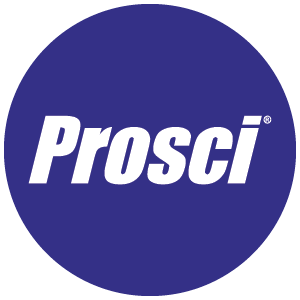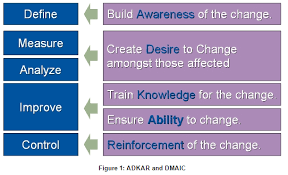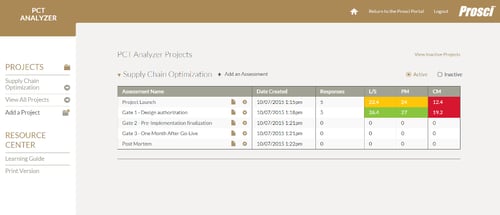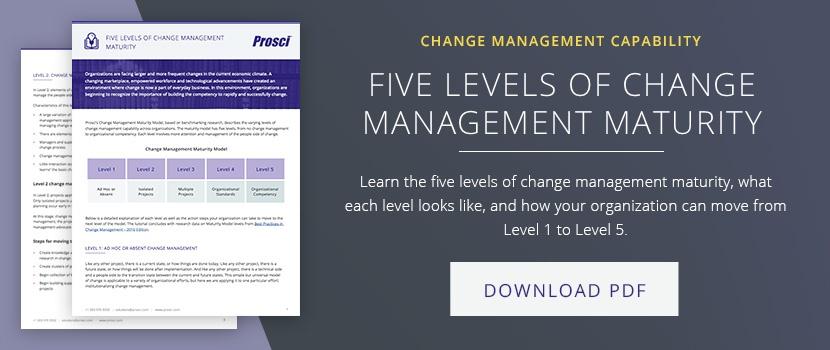How Change Management Fits with Six Sigma Success

5 Mins
Updated: August 10, 2022
Published: May 8, 2015

By Ric McCormick - Special guest author for the Change Management Learning Center
Working as a Lean Six Sigma black belt for a pharmaceutical solutions provider, I have to ensure I dedicate the required amount of effort to multiple projects running in parallel. Knowing merely the deliverables available at each phase for each project did not give the visibility required to effectively manage all aspects of a product portfolio.
Having used Prosci's change management methodology for some time, I was excited to see the team's work on the Prosci Change Triangle (PCT) and looked to integrate this into the Lean Six Sigma approach.
From a single project to enterprise level, the power of ADKAR and the PCT can greatly increase visibility and responsiveness over Lean Six Sigma projects and programs.
Lean Six Sigma, implemented at a site, or enterprise level is a large organizational cultural change. Implemented as a series of tools alone almost guarantees failure. Implemented with a robust change management strategy and methodology greatly increases the success of a LSS program.
The Lean Six Sigma Define, Measure, Analyze, Improve and Control (DMAIC) phases link clearly with Prosci's ADKAR change management Methodology and Tools (See Figure 1).

Once a Lean Six Sigma project has been chartered by a sponsor, the project team (typically cross-functional) is formed. During the launch, the team is introduced to the project goals and given the required level of training in the methodology to be used.
On project launch, it is imperative that the team understand the change resulting from the project and are on board from day 1. Using the Prosci ADKAR worksheet for Business Change Management during the launch, following an overview of ADKAR, is a powerful way to assess the team's interpretation of the project goals and its likelihood of success.
Remember, for most project team members, being part of a team of this nature may be a large change in itself. The business' past history with respect to projects and initiatives will have a large impact on team member's buy-in to the project.
Using ADKAR To Shape the Project and Gel the Team
At the end of the project launch session, explain clearly the Business Change Management Worksheet and give the team a suitable deadline prior to the next session to complete the assessment, ask the team to complete the assessment using their interpretation of the project and its effect on the business.
Collating the Responses
Responses to the assessments can be collated into a template, allowing a quick graphical overview of the team's thoughts on the anticipated changes and their impact.
Individually, the responses are a powerful insight into the team member's vision of the project. Collectively, the responses can go beyond this and be leveraged to bring the team together. From the profile, it is easy to see the overall view of the team and how the views of individual team members compare.
- Are the team's profiles coherent?
- Does one team member have a significantly differing profile to the rest of the team?
- Are there one or more parts of the assessment where the team clearly differ?
Discussing the Change and Molding the Project
In the next project session, discuss the profile with the team, highlighting the overall profile and where clear differences lie (keeping all responses and scores anonymous promotes a much more open discussion). To highlight the latter, bring up a collection of each of the comments from each of the ADKAR sections across each of the assessments. Discuss the comments in turn, with respect to the project as a whole and to different insights from each of the team members.
Using the assessment on paper and discussing as a team allows all to express their views either vocally or anonymously. This works as very much a "cards on the table" exercise where project deliverables can be defined to meet the concerns of the team relating to the project success and certainly cements the Desire aspect of the team itself.
Many positive benefits have been seen using the assessment in this way from identification of an extra business benefit and lean opportunity in the project to identifying during the Define phase the need to change the team structure at later project phases to ensure success.
Using the Prosci Change Triangle Model (PCT) In Toll Gates
It is clearly important to review the health of a Lean Six Sigma project at each of the DMAIC toll gates. This is typically performed on the project deliverables and schedule alone. Being able to capture the project health also with respect to both sponsorship and change management gives full visibility of true project health at each tollgate review.
Lean Six Sigma tollgate reviews are completed at the conclusion of each of the DMAIC phases of the project to assess with the sponsor (and the team) if the project is ready to progress to the next DMAIC phase or if the project is to be abandoned or if more work is required in the current phase before continuing.
Using the PCT Assessment on a project-by-project basis, go through the questions scoring 1 to 3 on each. This gives a PCT score for the Project Management, Sponsorship, Change Management and Success elements of a Lean Six Sigma project at the toll gate. Scores for some questions may be standard across all projects at a point in time-based on the business' current culture/environment.
The assessment can be completed either by the project lead, lead, and sponsor, or the entire team with the sponsor. If completed by the project lead alone, this must be discussed with the sponsor at the gate review. The main factor is to be open and honest when answering the questions.
For any questions scoring less than 3 discuss with the team and sponsor (even site leads / business leads if required) corrective actions necessary to increase the project health in each of the 3 key areas for the next project phase.
A good practice is to use the PCT score in project dashboards used at each project session with the team.
Using a PCT Dashboard for Project / Program Visibility
At the Black Belt, Master Black Belt, GM, or Deployment Leader position, visibility over project health for multiple projects is necessary to ensure successful deployment of Lean Six Sigma across a business. Having simple visibility across multiple projects/sites/business units beyond mere project deliverables and dates facilitates quick recognition and remedy of localized issues preventing program success.
In the example dashboard below the ADKAR profile from the Define Phase is used to indicate the phases in the project expected to be the toughest going.
Following this is the key PCT analysis throughout the project life cycle. At each phase we have the PCT scores for Sponsorship, Project Management and Change Management followed by an indicator of whether project risk has increased/decreased since the previous phase.
The final display is an overview of PCT health across the project phases.

Using this (or a similar) dashboard across multiple projects, multiple projects across multiple sites or many multiple projects across business units facilitates quick recognition of shortcomings in all project areas across a business.
- Training needs can be identified at a belt or Site / business level.
- Sponsorship issues can be identified at the same levels.
- Projects of declining health are easily visible.
- Projects / Belts / Sites / Business units can easily be recognized and leveraged for best practices in key areas across the business.
Much more information can be gained from such a visual system, the examples above are but a few.
Outcomes / The Next Steps
It's still quite early days for us here using the PCT, though we've been using the ADKAR profiles with much success for several years now. Whilst reviewing the material for this tutorial and discussions with Prosci there is still much more we can do to further bolster our successes in Lean Six Sigma here at Catalent, Including:
- Repeating the ADKAR Assessment in each project phase to analyze and leverage the insights gained from the changes in the team profile.
- More proactive use of the corrective actions from the PCT Assessment to ensure improved scores in later project phases.
The impact of using these tools and techniques here with project teams has been impressive. The ability to openly review a project and its implementation in our current culture, to get the buy in of a project team from day 1 and to address their own concerns and resistance with agreed actions, changing the shape of the project almost guarantees success.
Feedback from the teams on the use of these tools has been positive across the board.


